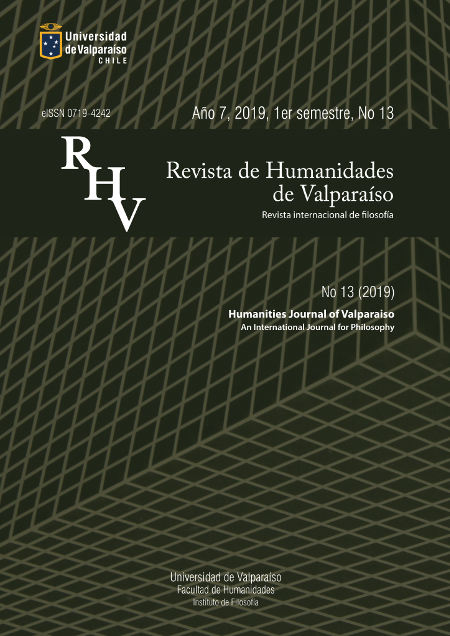Paraconsistencia total
DOI:
https://doi.org/10.22370/rhv2019iss13pp90-101Palabras clave:
filosofía, lógica, Negación, Transitividad, Monotonía, Lógicas paraconsistentes, ExplosiónResumen
Dentro del conjunto de las lógicas no clásicas, las lógicas paraconsistentes han suscitado de manera particular el interés de diversos filósofos. Además de las definiciones tradicionales, en los últimos años, se han propuesto nuevas maneras de caracterizar a la paraconsistencia. Lo que tienen en común todas estas definiciones es que alguna forma de la regla o de la metarregla de explosión debe ser rechazada. En este artículo, presentaré dichas definiciones y evaluaré el rol que juegan la negación y la transitividad en ellas. Finalmente, propondré una nueva caracterización de la paraconsistencia, la que llamaré paraconsistencia pura y mostraré que la regla de monotonía juega un rol crucial en todas las presentaciones de dicho concepto.
Descargas
Referencias
Anderson, A., Belnap, N. (1975). Entailment, Vol. I. Princeton: University Press. doi: 10.2307/2272137
Avron, A. (1991). Simple consequence relations. Information and Computation, 92(1): 105-139. doi: 10.1016/0890-5401(91)90023-U
Asenjo, F. G. (1966). A calculus of antinomies. Notre Dame Journal of Formal Logic, 7(1): 103-105. doi:10.1305/ndjfl/1093958482
Barrio, E. (2018). Models & Proofs: LFIs without a Canonical Interpretation. Principia, 22(1): 87-112 doi: 10.5007/1808-1711.2018v22n1p87
Barrio, E., Pailos, F., Szmuc, D. (2018). What is a paraconsistent logic? En W. Carnielli, J. Malinowski (eds.), Contradictions, from Consistency to Inconsistency, pp. 89-108. Cham: Springer. doi: 10.1007/978-3-319-98797-2_5
Barrio, E., Pailos, F., Szmuc, D. (2019). A Hierarchy of Classical and Paraconsistent Logics. Journal of Philosophical Logic. doi.org/10.1007/s10992-019-09513-z
Beall, J. (2011). Multiple-conclusion LP and default classicality. The Review of Symbolic Logic, 4(2): 326-336. doi:10.1017/S1755020311000074
Bobenrieth, A. (1998). Five philosophical problems related to paraconsistent logic. Logique et Analyse, 41(161-163): 21-30.
Carnielli, W., Coniglio, M. (2016). Paraconsistent logic: Consistency, contradiction and negation. Switzerland: Springer International Publishing. doi: 10.1007/978-3-319-33205-5
Cobreros, P., Égré, P., Ripley, D., Van Rooij, R. (2013). Reaching transparent truth. Mind, 122(488): 841-866. doi: 10.1093/mind/fzt110
da Costa, N. (1974). On the theory of inconsistent formal systems. Notre Dame Journal of Formal Logic, 15: 497-510. doi: 10.1305/ndjfl/1093891487
da Costa, N., Lewin, R. (1995). Lógica paraconsistente. En C. Alchourrón, J. Méndez, R. Orayen (eds.). Lógica. Enciclopedia IberoAmericana de Filosofía, Vol. 7, pp. 185-204. Madrid: Trotta.
Mares, E., Meyer, R. (2001). Relevant Logics. En Goble, Lou (ed.), The Blackwell Guide to Philosophical Logic. Oxford: Blackwell.
Mares, E. (2004). Relevant Logic: a Philosophical Interpretation. Cambridge: Cambridge University Press. doi:10.1017/CBO9780511520006
Paoli, F. (2002). Substructural logics: a primer. Dortrech: Springer Netherlands. doi: 10.1007/978-94-017-3179-9
Plumwood, V., Routley, R., Meyer, R., Brady, R. (1982). Relevant Logics and its Rivals, Volume I. Atascardero, CA: Ridgeview. doi: https://doi.org/10.2307/2275039
Priest, G. (1979). The logic of paradox. Journal of Philosophical logic, 8(1): 219–241. doi:10.1007/BF00258428
Priest, G. (2006). In Contradiction: A Study of the Transconsistent. Oxford: Oxford University Press. doi: 10.2307/2219835
Ripley, D. (2013). Revising up: Strengthening classical logic in the face of paradox. Philosophers Imprint, 13(5): 1-13. url: http://hdl.handle.net/2027/spo.3521354.0013.005
Routley, R., Meyer, R. (1976). Dialectical logic, classical logic, and the consistency of the world. Studies in East European Thought, 16(1): 1-25. doi: 10.1007/BF00832085
Urbas, I. (1990). Paraconsistency. Studies in Soviet Thought, 39(3-4): 343-354. doi: 10.1007/BF00838045
Descargas
Publicado
Número
Sección
Licencia
Aquellos autores/as que tengan publicaciones con esta revista, aceptan los términos siguientes:
- Los autores/as conservarán sus derechos de autor y garantizarán a la revista el derecho de primera publicación de su obra, el cual estará simultáneamente sujeto a la Licencia de reconocimiento de Creative Commons (CC BY-NC-ND 4.0 International) que permite a terceros compartir la obra siempre que se indique su autor y su primera publicación esta revista.
- Los autores/as podrán adoptar otros acuerdos de licencia no exclusiva de distribución de la versión de la obra publicada (p. ej.: depositarla en un archivo telemático institucional o publicarla en un volumen monográfico) siempre que se indique la publicación inicial en esta revista.
- Se permite y recomienda a los autores/as difundir su obra a través de Internet (p. ej.: en archivos telemáticos institucionales o en su página web) antes y durante el proceso de envío, lo cual puede producir intercambios interesantes y aumentar las citas de la obra publicada. (Véase El efecto del acceso abierto).







